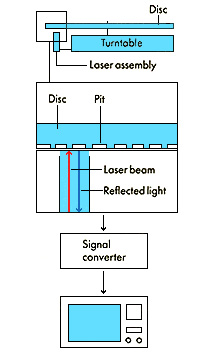Videodisc, also spelled video disk or videodisk, is a flat, round platter on which visual images and sound have been recorded for reproduction on a television set. The term videodisc has been applied most often to an optical disc about 12 inches (30 centimeters) in diameter. Such a disc is often called a laserdisc because a device known as a laser is used to play back the information on it. After the introduction of a video format called DVD in 1996, manufacturers stopped producing videodiscs and videodisc players (see DVD ).

A videodisc is viewed using a special player that can be hooked up to any TV set. The player cannot record material. In the home, videodisc players have been used primarily for viewing motion pictures and concerts of popular and classical music. Schools and businesses have used videodisc presentations for teaching and training.
Videodiscs are made of plastic with a reflective metal coating. The surface of a videodisc is covered with billions of microscopic pits that wind in a spiral track. The pits form a code representing the recorded pictures and sounds. Inside the player, a laser aims a concentrated beam of light at the spiral track as the disc spins. The light reflects off the pits in a pattern that is read by a light-sensitive device in the player. The player converts the pattern into TV signals.
Most videodiscs store visual information in analog form, in which the patterns of the pits and spaces are based on television signals that represent the original images. The sound has been recorded in either analog form or in digital (numerical) form.
Manufacturers began developing videodisc systems in the early 1970’s. The growing popularity of videocassette recorders (VCR’s) in the early 1980’s hurt sales of videodisc players. During the late 1980’s and early 1990’s, interest in videodiscs grew because videodiscs provided a clearer TV image than did videocassettes. During this period, several manufacturers introduced combination players, which could play audio compact discs (CD’s) as well as videodiscs.
In the late 1990’s, videodiscs declined in popularity as movies stored on DVD achieved wide acceptance. A DVD is the same size as a CD, about 43/4 inches (12 centimeters) in diameter. A single DVD can easily hold a complete motion picture as well as six-channel surround-sound audio, which provides extremely lifelike sound reproduction.
